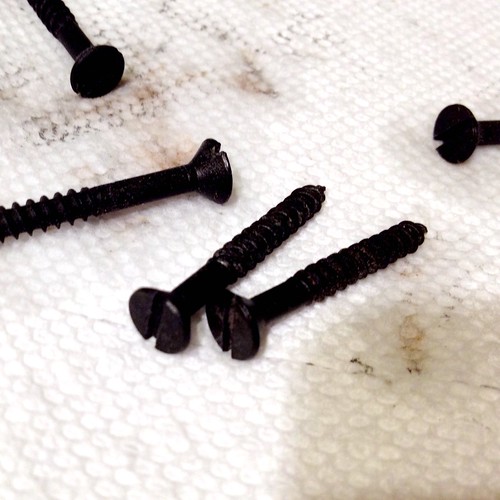Friday, February 24, 2012
One thing's for sure here at Old Town Home -- we're dedicated to the detail work that often goes unnoticed. In my personal opinion, the detail work often makes the project a true success. Though the detail items that exist may not be so important for the casual observer, a missing or incorrect detail item may be the thing that actually ruins the end result.
Yesterday we wrapped up our vestibule project with a summary blog post that did a quick run down of the major elements of our project, but many of the tiny details we painstakingly implemented were omitted for the sake of time. One such detail is actually a tip I picked up several years ago when we first started installing salvaged hardware on our linen closet door.
Prior to living in our house I sort of felt that a screw was a screw, was a screw. Slot head or Philips, black, silver, or blue, they were all the same to me. But once I started to get into home restoration I began to notice the subtle but significant differences between the various types and styles of screws, and where it was or wasn't appropriate to use each one.
When it comes to salvaged hardware, the age and materials of the hardware dictate that it is important to use slot head black screws for almost all of our projects. My search for these elusive hardware supplies led me to the discovery that they weren't readily available for purchase. Left with no viable purchase options, I searched the internet and stumbled on a random message board post talking about a substance that darkens the steel barrel of the gun to restore its finish. With that I learned about this extremely simple process to essentially antique a steel (but not stainless) screw. Just look at this photo and you'll see how badly the wrong color screws stand out and ruin an otherwise nice looking project.
To remedy this issues, we needed to make a couple of screws for our French door hinges and lock set hardware look old, so I chronicled the process of darkening. Here are the simple steps I follow to antique screws for installation on salvaged hardware.
1. The secret to my success is something called Gun Blue. It's made for what it sounds like -- you put it on the steel barrel of a gun to turn the metal a dark black/blue. This solution turns the surface of the steel it touches blue and makes things like screws look very aged.
I bought a small container of this gun blue from a gun supply store nearly eight years ago, and I'm still using the same bottle. You can purchase the substance on Amazon or through a variety of other gun accessory dealers.
Beyond the gun blue you'll need some paper towels, a long magnetic bit or rod to grab the screws, and a few minutes of time.
2. This next step is super scientific, so try to stick with me. I take the screws I want to age and I drop them right into the gun blue bottle and swish them around. That's it, that's all there is to it. Super complex, I know!
3. After allowing the screws to sit in the gun blue for a couple of minutes (approximately three), I use a magnetized screwdriver drill bit to remove the screws from the bottle. But be sure to note that the drill bit will also darken from this removal.
4. After I remove them from the gun blue I drop them on a paper towel and rub them dry. What I'm left with is a couple of beautifully aged screws that look perfectly at home on 100+ year old salvaged hardware.
5. The final step is to actually install the screws on the hardware that needs them. Every time I install screws that I've darkened, I get a tremendous amount of gratification from it. It just feels like I'm doing the right thing and doing a service for our house.
Pretty easy, don't you think? A frequent blog commenter, JC, who also runs the blog "My 1923 Foursquare" was discussing this very topic with me a couple months ago. He has lots of tips and tricks for aging items and he suggested gun blue in a comment he left. I was quite happy to learn that I was doing it right. He also said that vinegar tends to work as well. Makes perfect sense since vinegar is an acid. I'll have to give it a try when I finally run out of my nearly decade bottle of gun blue.
Do you have any hints, tips, or tricks you use to do something similar? Or perhaps you've been searching for a suggestion like this like I once was. If so, let us know where you're going to use them.

![]()
![]()